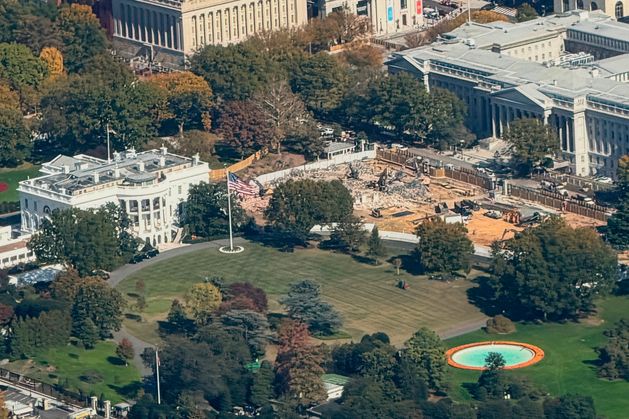Tours of the White House are out of the question, not least because the visitor entrance, which happened to be in the East Wing, is now a closed-off rubble-strewn demolition site, where Trump’s vision for a grand golden 8,361 sq m ballroom will soon take shape.
Groups of school students and couples on holiday still gazed through the railings this week at the US National Historic Landmark that has served as the president’s residence since 1800.
But the view of the East Wing, expanded in 1942, is blocked by high barricades. Only the tops of two giant extractors peek above the fencing in clouds of dust and din, horrifying preservationists, Democratic lawmakers and at least a few American tourists.
“This country is full of homeless people with nothing to eat, and this moron is spending this kind of money on this?” said Jonathan Fineberg (79) who was visiting on Thursday from Philadelphia.
His wife, Marianne Malone Fineberg, was not reassured by Trump’s renovation work from earlier this year, when he had the White House’s Rose Garden lawn paved over and dotted with yellow patio umbrellas. “Now it looks like an overpriced hotel somewhere,” she said.
Some tourists lofted iPhones high above their heads, trying fruitlessly for a clear shot of whatever had just happened to what was the East Wing, which had traditionally housed the offices and staff of the president’s spouse.
Trump, a Republican who likes to cite his architectural acumen acquired as a former real-estate mogul in New York City, says they aren’t missing much and no one should mourn its demise.
“It was a very small building,” Trump told reporters this week, already using the past tense after his earlier pledge that his changes to the existing White House complex would not be so drastic. “There was a storey added on, which was not particularly nice.”
Some conservatives have defended Trump and his efforts to modernise what they say is an old and perennially too-small building. Victoria Coates, a vice president at the Heritage Foundation think-tank, wrote in a social media post that the ballroom “will be a great addition to the White House, not some egregious aesthetic affront”.
Democratic lawmakers have said Trump’s changes have not gone through the proper channels and criticised the funding. The price tag, now some $300 million (€258m), is being covered by private donors, including some US technology companies such as Google and an unspecified fraction by Trump himself.
Trump’s staff say the president does not need permission for the demolition and that the construction plans would soon be sent on to the National Capital Planning Commission, an agency currently chaired by Trump’s White House staff secretary.
“He was dishonest about his intent in terms of ‘we’re not going to touch anything, like it’s going to be close, but not touching’,” said Kevin Wade, a 52-year-old tech worker visiting the capital from Texas. “And then now we’re completely demolishing it.”
Addison Nguyen, a 32-year-old pharmaceutical company employee, made his appraisal as he showed visiting relatives around Washington ahead of his weekend wedding.
“It’s ultimately a vanity project for Trump,” he said. “It seems like there’s no real checks and balances to what sort of decisions he can make.
“The ballroom, sad to say, it’s one of the least things that I’m worried about.”
